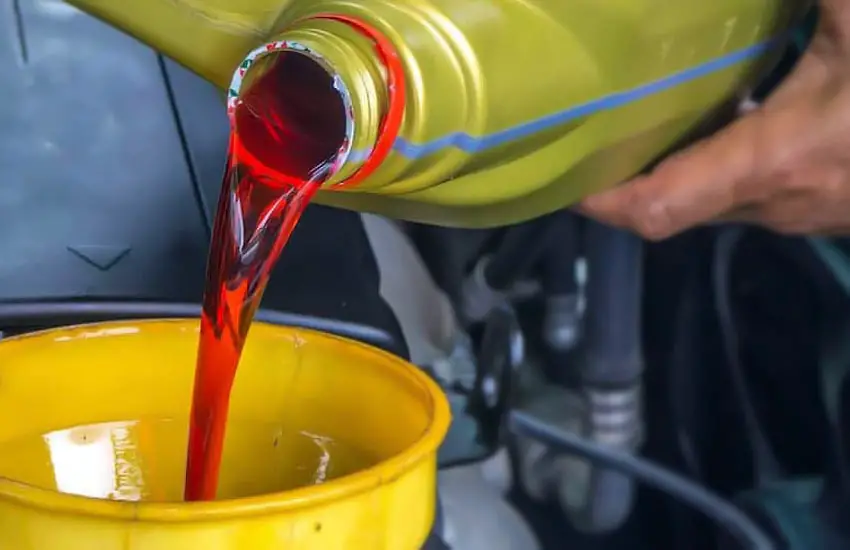As an Amazon Associate, I earn from qualifying purchases at no extra cost to you.
Understanding Automatic Transmission Fluid: What You Need to Know!
You might have heard about automatic transmission fluid (ATF) but aren't sure what it actually does. It's important to know because ATF keeps your car's transmission running smoothly. In this blog post, we'll break down what automatic transmission fluid is, why it's so important, and how to check and change it. Whether you're a new driver or just looking to learn more about car maintenance, this guide will help you understand ATF and keep your car in great shape!
What is Automatic Transmission Fluid?
Automatic transmission fluid, or ATF, is a special type of oil used in cars with automatic transmissions. It helps the transmission work smoothly and keeps everything running well. Think of ATF like the blood in a car’s veins. It flows through the transmission and helps it shift gears smoothly.
ATF does more than just help with shifting. It also cools the transmission and keeps it clean. When your car’s transmission gets hot, ATF helps cool it down. It also stops dirt and tiny bits of metal from building up, which can cause problems.
There are different types of ATF for different cars. It’s important to use the right kind for your vehicle, as recommended by the car manufacturer. Using the wrong type can lead to shifting problems and other issues.
You usually need to check and change the ATF at regular intervals. Your car’s owner manual will tell you when to do this. If the ATF is low or dirty, it can cause problems with shifting gears, which might make driving harder.
In short, ATF is crucial for keeping your car’s automatic transmission in good shape. It helps with smooth gear changes, cools the transmission, and keeps it clean. Regular checks and changes help keep your car running well.

Why is Automatic Transmission Fluid Important?
Automatic Transmission Fluid (ATF) is super important for your car. It keeps your transmission working smoothly. The transmission is like the heart of your car’s driving system. It helps your car shift gears, which is needed for speeding up or slowing down.
ATF does a few key things. First, it lubricates the parts inside the transmission. Just like oil keeps your engine from getting too hot, ATF keeps the transmission parts from grinding against each other and wearing out. Second, ATF helps with cooling.
The transmission gets hot when it works hard, and ATF helps to carry away that heat so the transmission doesn’t overheat. Lastly, ATF also helps in shifting gears smoothly. It makes sure that when you change gears, the process is smooth and not jerky.
Without enough ATF, or if the fluid is dirty, your transmission can have problems. It might shift roughly or even stop working. Regularly checking and changing the ATF can help avoid big repairs. So, it’s a good idea to keep an eye on the transmission fluid level and get it changed when needed. This simple step helps keep your car running well and can save you from costly repairs down the road.
How to Check Your Automatic Transmission Fluid
Checking your automatic transmission fluid is important for keeping your car running smoothly. If your transmission fluid is low or dirty, it can cause shifting problems or even damage your transmission. Here's a simple guide on how to check it.
Gather Your Supplies
Before you start, make sure you have everything you need. You will need a clean cloth or paper towel, a funnel, and the right type of transmission fluid for your car. Check your car's owner's manual to know which fluid to use.
Park Your Car on a Level Surface
First, park your car on a flat surface. This helps get an accurate reading of the fluid level. Make sure the engine is warm but turned off. If the car has been running, wait a few minutes for the engine to cool down a bit before you start.
Locate the Transmission Dipstick
Next, find the transmission dipstick. It's usually located near the back of the engine. It might be labeled with a colored handle. If you have trouble finding it, consult your owner's manual for its exact location.
Pull Out the Dipstick
Pull out the dipstick carefully. Wipe it clean with your cloth or paper towel. This step is important because it removes any old fluid that might give a false reading.
Check the Fluid Level
Insert the dipstick back into the tube and then pull it out again. Look at the markings on the dipstick to see where the fluid level falls. There are usually two marks: "Full" and "Add" or "Low." The fluid level should be between these marks. If it's low, you'll need to add more fluid.
Inspect the Fluid Condition
While you have the dipstick out, check the condition of the fluid. It should be a clear red or pink color. If the fluid looks dark brown or has a burnt smell, it might be time for a transmission fluid change. Also, if you see any metal particles on the dipstick, it could mean there's a problem inside the transmission.
Add Transmission Fluid if Needed
If the fluid level is low, add more transmission fluid. Use a funnel to pour the fluid into the dipstick tube. Be careful not to overfill, as too much fluid can cause other problems. Add a little at a time, and check the level frequently to avoid overfilling.
Recheck the Fluid Level
After adding fluid, recheck the level with the dipstick. Make sure it is between the "Full" and "Add" marks. This step ensures you've added enough fluid without overdoing it.
Clean Up and Replace the Dipstick
Once you're done checking and adding fluid, clean up any spilled fluid and put the dipstick back into its tube. Make sure it is fully inserted to avoid any leaks.
Check for Leaks
After you've replaced the dipstick, start your engine and let it run for a few minutes. Then, check underneath your car for any signs of leaks. If you see transmission fluid on the ground, it might indicate a leak that needs to be repaired.
Regular Checks
Checking your transmission fluid regularly is a good habit. Aim to check it at least once a month or before long trips. Keeping an eye on the fluid level and condition can help you catch problems early and keep your transmission in good shape.
By following these simple steps, you can easily check your automatic transmission fluid and ensure your car runs smoothly. If you notice any issues or if the fluid needs frequent topping up, it's a good idea to have a mechanic take a look. Regular maintenance helps your car stay in top condition and can prevent costly repairs down the road.
Common Signs of Low or Dirty Transmission Fluid
Transmission fluid is important for keeping your car's transmission running smoothly. When it's low or dirty, your car might show some signs that something's wrong. Here's what to watch for.
Slipping Gears
If you notice that your car's gears are slipping, it might be a sign of low or dirty transmission fluid. Slipping gears mean your car can't stay in the gear you selected. You might feel the car jerk or hesitate when accelerating. If this happens, check your transmission fluid level and quality. Low fluid or dirty fluid can cause this problem.
Hard Shifting
Another sign is hard or rough shifting. If your car feels like it's struggling to change gears, the transmission fluid might be low or dirty. Normally, shifting gears should be smooth. If you feel a sudden jolt or roughness when the car shifts, it's a good idea to check the fluid.
Unusual Noises
Listen for unusual noises from your transmission. If you hear whining, clunking, or grinding sounds, dirty or low transmission fluid might be the cause. These noises can happen because the fluid is not lubricating the parts properly. Check your transmission fluid and look for any signs of contamination.
Warning Lights
Most modern cars have warning lights that come on if there's a problem with the transmission. If you see a transmission warning light on your dashboard, it could mean that your transmission fluid is low or dirty. Don't ignore this light. Check the fluid as soon as possible to avoid more serious damage.
Burning Smell
A burning smell coming from your car can be another sign of transmission problems. If the fluid is old or dirty, it might overheat and produce a burning smell. This smell is often a sign that the fluid needs to be changed. Check the fluid level and condition to see if it needs attention.
Hard to Get Into Gear
If your car has trouble getting into gear, it might be due to low or dirty transmission fluid. This problem can make it hard to shift into different gears smoothly. If you find it difficult to get your car into gear or if it feels like it's stuck, check the transmission fluid.
Fluid Color and Condition
Transmission fluid should be red or pink and clear. If it looks dark brown or has a burnt smell, it's dirty and needs to be changed. You can check the fluid by looking at the dipstick, which is usually marked with a bright color and labeled for transmission fluid. If the fluid looks dirty, it's time for a change.
Delayed Response
If your car has a delay when you put it into gear or if it takes longer to respond when you accelerate, this might be a sign of low or dirty transmission fluid. The delay happens because the transmission fluid isn't doing its job properly. Check the fluid to see if it needs to be topped up or changed.
Leaking Fluid
Check for any leaks under your car. Transmission fluid leaks are often red or pink and have a sweet smell. If you see a puddle or spots of this fluid, you might have a leak. Low transmission fluid due to a leak can cause all of the signs mentioned above. Addressing a leak quickly can help prevent further damage.
Keeping an eye on these signs can help you catch problems with your transmission fluid early. Regularly checking and changing your transmission fluid is important to keep your car running smoothly. If you notice any of these signs, it's a good idea to get your car checked by a professional. This way, you can avoid bigger issues and keep your car in good shape.
How to Change Automatic Transmission Fluid
Changing automatic transmission fluid (ATF) is important to keep your car running smoothly. Over time, the fluid can get dirty and lose its effectiveness. Here's a step-by-step guide to help you do it yourself.
Gather Your Tools and Materials
Before you start, make sure you have everything you need:
- New automatic transmission fluid
- Transmission filter (if needed)
- Transmission pan gasket
- Socket wrench set
- Oil filter wrench
- Funnel
- Drain pan
- Jack and jack stands (or ramps)
- Safety gloves
Lift Your Car
First, you need to lift your car to get underneath it. You can use a jack to lift the car and then place jack stands underneath to keep it safely elevated. Alternatively, you can drive your car up ramps if you have them. Make sure the car is secure before you start working.
Locate the Transmission Pan
Next, find the transmission pan. It's usually located under the car, towards the middle. It's a metal pan that helps hold the transmission fluid. Look for bolts around the edges of the pan. These bolts need to be removed to access the fluid.
Drain the Old Fluid
Place the drain pan under the transmission pan to catch the old fluid. Carefully remove the bolts from the pan. Some fluid may start to drain out as you loosen the bolts. Let the fluid drain completely into the pan. Be careful, as the fluid can be hot if the engine was running recently.
Remove the Old Filter
Once the pan is off, you may see a filter inside the transmission. Remove the old filter. It might be held in place by screws or clips. Make sure to take out all the old filter pieces.
Install the New Filter
Place the new filter where the old one was. Make sure it fits snugly. Secure it with screws or clips as needed.
Clean the Pan and Gasket
Before reinstalling the pan, clean it thoroughly. Remove any old gasket material from the pan and the transmission. Place the new gasket on the pan.
Reattach the Pan
Carefully place the transmission pan back onto the transmission. Align the holes with the bolts and screw them in place. Tighten the bolts in a criss-cross pattern to ensure an even seal.
Add New Transmission Fluid
Locate the transmission fluid fill hole. This is usually on top of the transmission. Use a funnel to pour the new transmission fluid into the hole. Check your car's manual for the correct type and amount of fluid.
Check the Fluid Level
After adding the fluid, start the car and let it run for a few minutes. This allows the new fluid to circulate. Check the fluid level using the dipstick, if your car has one. Add more fluid if needed until it reaches the correct level.
Lower Your Car
Once everything is in place, carefully remove the jack stands or drive off the ramps. Lower the car back to the ground. Make sure everything is secure and check for any leaks under the transmission pan.
Test Drive
Take your car for a short drive to make sure the new fluid is working correctly. Pay attention to how the transmission shifts. If you notice any problems, check the fluid level again and look for leaks.
Changing the automatic transmission fluid can be a bit messy, but it's a crucial maintenance task. By following these steps, you'll help keep your transmission running smoothly and extend the life of your car.
I hope this guide helps you understand automatic transmission fluid better. Knowing how to check and maintain it can keep your car running smoothly. Regular checks can prevent problems and extend the life of your transmission. Remember to follow the steps we discussed and always refer to your car's manual for specific details.
Questions in Your Mind
Is it necessary to change the transmission fluid?
Yes, it is necessary to change the transmission fluid regularly. Over time, the fluid can become dirty and lose its effectiveness, which can lead to transmission problems.
Can I use any type of transmission fluid for my car?
No, you should use the type of transmission fluid specified in your car's owner manual. Using the wrong type can cause damage to your transmission.
Do I need to change the transmission filter every time I change the fluid?
It's a good idea to change the transmission filter every time you change the fluid. A new filter ensures that contaminants are removed effectively.
Is it okay to drive without changing the transmission fluid?
Driving without changing the transmission fluid can lead to transmission damage. Dirty or old fluid can cause shifting problems and other issues.
Can I change the transmission fluid myself or should I go to a mechanic?
You can change the transmission fluid yourself if you are comfortable with the process and have the right tools. Otherwise, a mechanic can do it for you.
Do I need to warm up my car before changing the transmission fluid?
It is a good idea to warm up your car slightly before changing the transmission fluid. Warm fluid flows better and can help drain more of the old fluid.
Can I mix different brands of transmission fluid?
It's best not to mix different brands of transmission fluid. Stick to the brand and type recommended in your car's owner manual.
Is it possible to overfill the transmission fluid?
Yes, overfilling the transmission fluid can cause overheating and damage to the transmission. Be sure to add the correct amount as specified in your owner manual.
Do I need to use a specific tool to remove the transmission pan bolts?
You should use a socket wrench set to remove the transmission pan bolts. A specific tool is not required, but a proper socket wrench will make the job easier.
Can old transmission fluid affect the performance of my car?
Yes, old transmission fluid can affect the performance of your car. It can cause rough shifting, slipping, and other transmission issues. Regular changes help maintain smooth operation.











